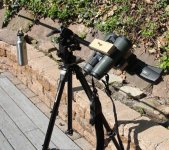I use a 10X50 SV hand-held during the day and mounted at night for astronomy.I have been looking for an SLC 10x56 for astro use however they are impossible to find in the U.S. Have you an opinion regarding your 8x56 at night?
George
Are you using a binocular mount for astronomy use?I have been looking for an SLC 10x56 for astro use however they are impossible to find in the U.S. Have you an opinion regarding your 8x56 at night?
George
I purchased a 10X50 SV primarily for backyard astronomy use, though I often use it during the day. I immediately constructed a binocular mount that allows me to lie back in a chair, align the binoculars to my eyes and sit back and watch a completely stabilized view of the night sky. The difference between hand-held and stabilized viewing with a binocular is impossible to explain. For me, it's the difference between OK and WOW that's truly amazing. I also mount the following: 7X42 SLC, 8.5X42 SV, 8X32 SV and my Nikon 8X32 SE. Mounted, the best choice I have is the 10X50 SV. For casual hand-held sessions I prefer the 7X42 SLC, though my wife's 8X32 SV is the stellar hand-held choice for pure enjoyment.I have been looking for an SLC 10x56 for astro use however they are impossible to find in the U.S. Have you an opinion regarding your 8x56 at night?
George
The so-called flat field of the SV is a real benefit when viewing the night sky.
Here's a photo...






